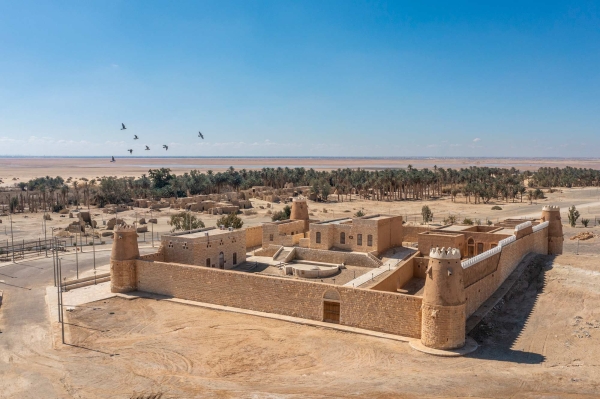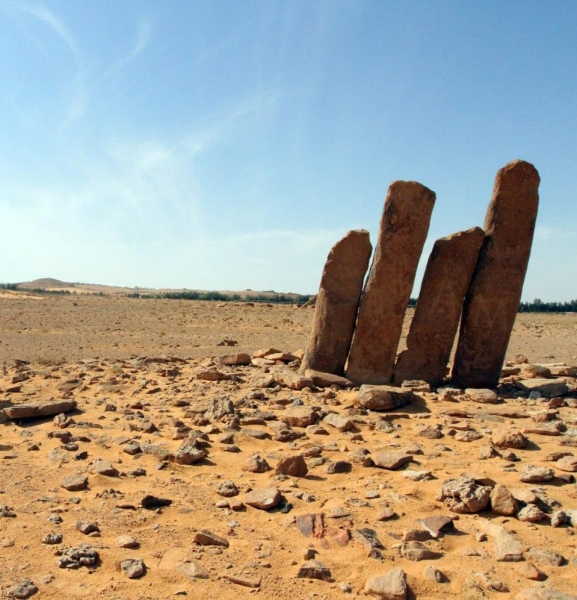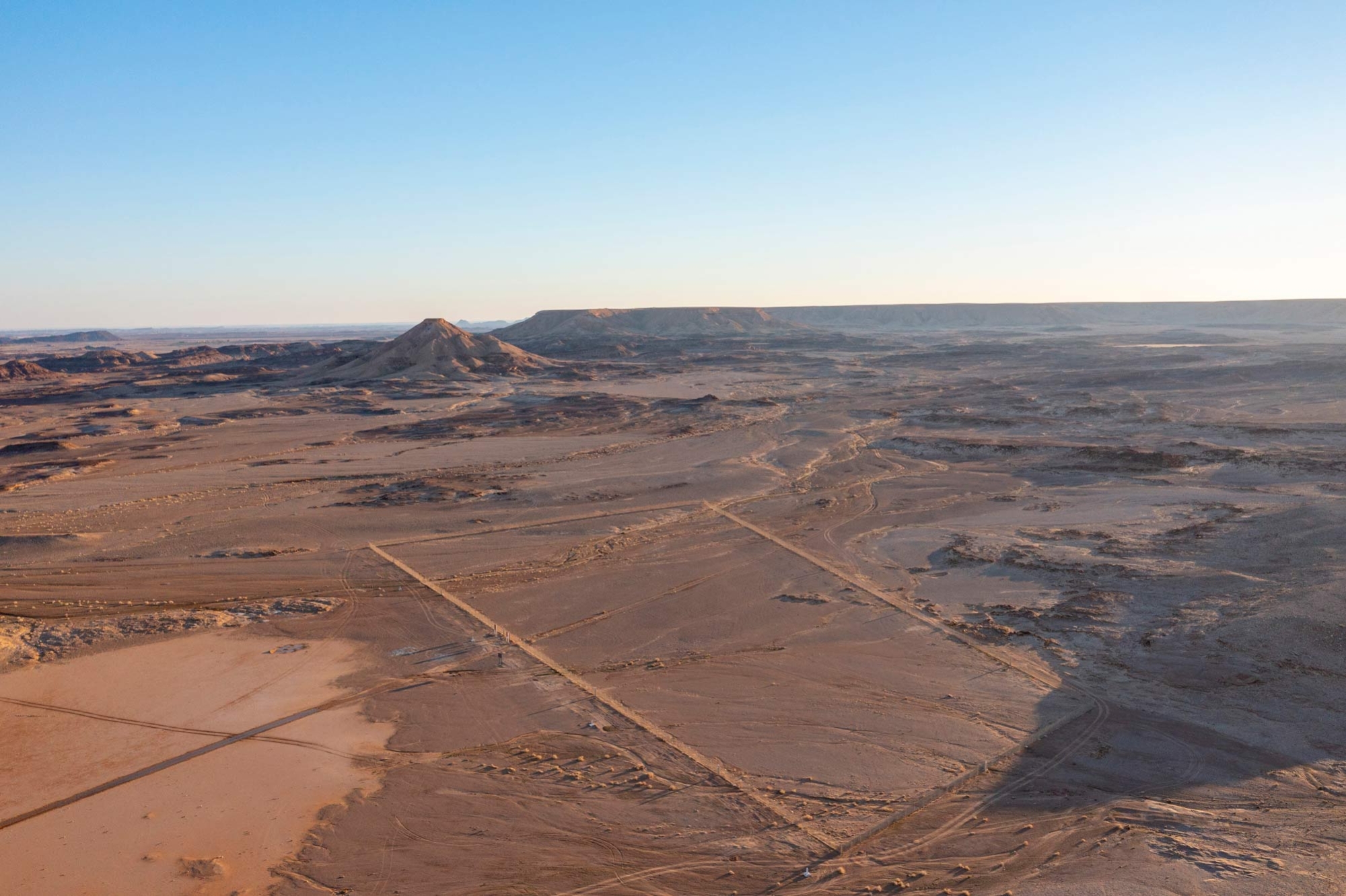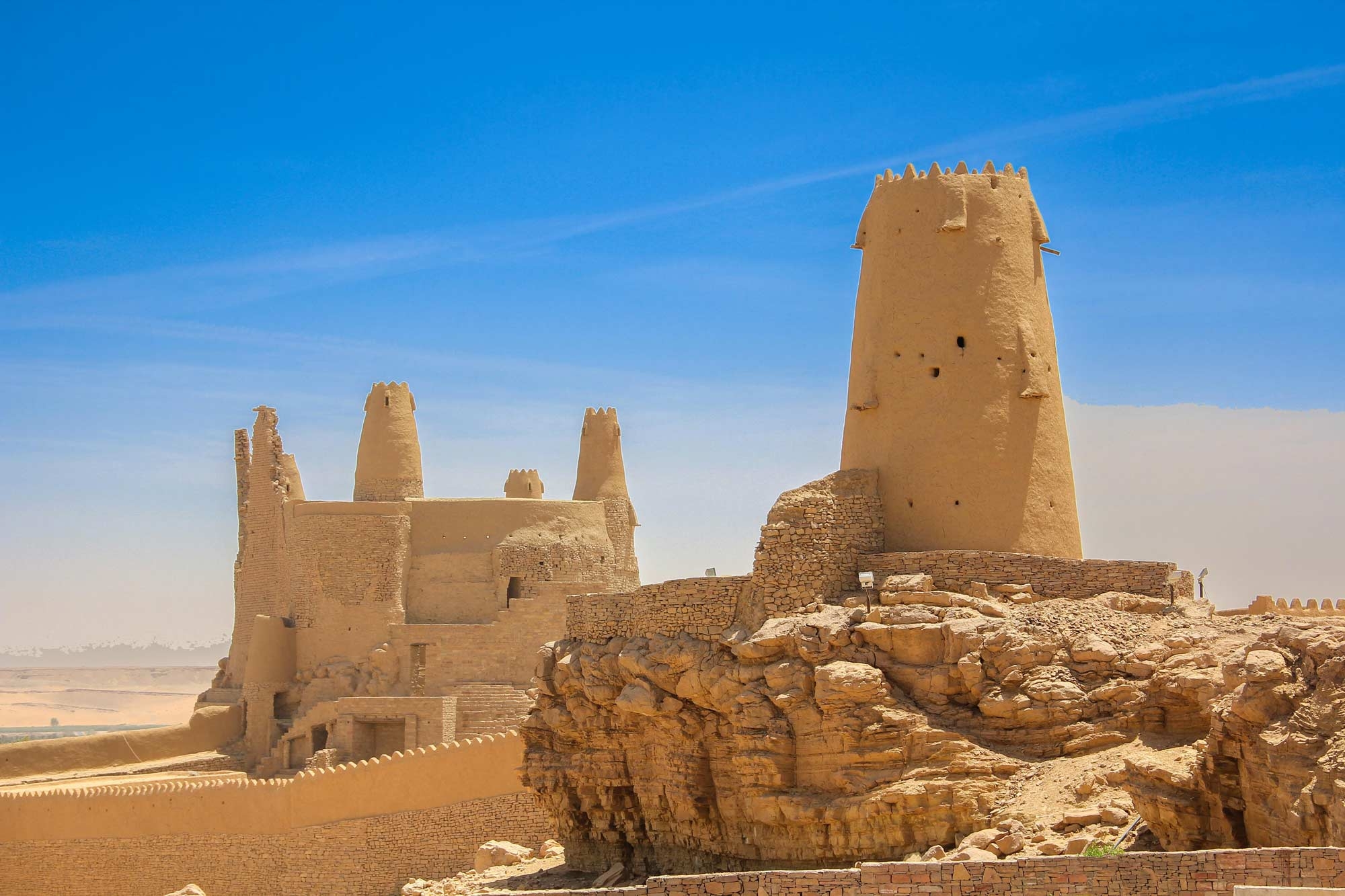


The Antiquities in al-Jawf Province are the material remains and legacies of ancient human civilizations in al-Jawf Province, located in the northwest of the Kingdom of Saudi Arabia. These include stone inscriptions, drawings, and Thamudic and Nabataean writings. Al-Jawf is considered one of the Kingdom’s provinces rich in such antiquities, including ash-Shuwayhitiyyah site, one of the oldest human settlements in history.
The antiquities in al-Jawf Province during prehistoric times
Field research teams have documented the presence of antiquities in al-Jawf Province that date back to prehistoric times, which are the periods before the production of metals. During this era, humans relied on stone tools, and such artifacts have been found in several locations throughout the province.
Stone-cut tools and several primitive axes were discovered north and southeast of the Sakaka Basin and south of al-Kihayfiyah, dating back two hundred thousand years BCE.
In Wadi as-Sirhan, many stone circles were found, scattered across its land, along with flint tools dating back to around the fourth millennium BCE during the Neolithic period. In a period close to that time, with the beginning of the metalworking era, stone pillars facing the sun were discovered at al-Rajajil site, belonging to the Copper Age.

Antiquities in al-Jawf Province during pre-Islamic era
Al-Jawf Province was mentioned in Assyrian texts during the eighth century BCE under the name "Adumatu," referring to Dawmat al-Jandal. Among the Assyrian texts discovered are wall murals in the northern palace of the Assyrian King Ashurbanipal (668 BCE – 626 BCE). The scenes depict a battle between the Arabs and the Assyrians, showing the Arabs riding camels while the Assyrians are mounted on horses.
A collection of archaeological artifacts dating back to the late first millennium BCE was discovered at al-Tuwayr archaeological site, which includes a variety of pottery items.
Ancient Arabian (Thamudic) inscriptions are abundant on the rock faces in al-Jawf Province. The earliest references to the civilization of that period date back to the eighth century BCE, with the inscriptions ranging in date from the eighth century BCE to the third century CE.
A coin attributed to the Nabataean period was found in Dawmat al-Jandal Governorate, featuring Shaqilat, the wife of the Nabataean King Aretas IV, who ruled from 9 BCE to 40 CE. Additionally, pottery fragments, a Nabataean inscription, and pottery pieces from the same era were discovered near the Mosque of Omar Bin al-Khattab.
Al-Jawf Province is one of the provinces in the Arabian Peninsula rich in drawings, inscriptions, and various forms of ancient Arabian writings. Approximately 11,400 drawings have been recorded on 1,085 rocks, including a depiction at the Ithra site, which shows a human figure with long hair and outstretched arms. Another inscription at Wadi al-Shati site was created by engraving on a hard granite rock, representing a human figure with a slender neck, a round head, and legs shaped like two sticks.
Al-Tuwayr site is rich in rock art depicting animals such as camels, ostriches, donkeys, and ibexes, as well as Thamudic inscriptions. There are also carvings representing horsemen carrying long spears, along with tribal markings indicating their affiliations.
In the northwest of Sakaka City, there is a drawing of two human figures wearing helmets, along with a depiction of a lion accompanied by a Kufic inscription dated to the year 761.
Among the inscriptions discovered in al-Jawf Province are one from al-Qadeer site, south of Sakaka, and another from al-Qal'ah site in Sakaka City.
The oldest Nabataean inscriptions found in the province include a text from the reign of Aretas IV, dated to the year 4, and another inscription from the same period dated to the year 27, written within a frieze. The most recent inscription dates back to the reign of King Rabbel II, dated to the year 71.
Antiquities in al-Jawf Province during the Islamic eras
Field studies and archaeological surveys in al-Jawf Province have revealed the presence of numerous Islamic inscriptions and writings engraved on rock faces and stones.
A text was discovered northwest of al-Muaysin site near Dawmat al-Jandal, written inside a rock drawing of a lion, along with other inscriptions containing religious invocations. Additional inscriptions were found at Qarat al-Naysa, west of al-Muaysin Palace, and others at al-Qara'a, west of Sakaka City, spread across rocks and mountains.
An early Islamic inscription was found on the facade of a stone wall in Ithra Palace in al-Qurayyat Governorate, along with another inscription in Harrat al-Rashrashiyah, north of al-Qurayyat.
Historical monuments in al-Jawf Province
Ash-Shuwayhitiyyah Site
Ash-Shuwayhitiyyah archaeological site is located forty-five km north of Sakaka City and is considered one of the oldest sites in the ancient Near East. Analytical studies estimate its age to be around 1.3 million years. Quartz stone tools were discovered at the site, along with many other stone tools classified as belonging to the pre-Acheulean period. The human settlement at the site is estimated to be around one million years old.
Al-Saidi Castle
Located at the summit of a mountain known by this name, near the Kaf site, the structure consists of a rectangular stone wall built from basalt that surrounds the entire peak of Mount al-Saidi. The wall stretches approximately eight hundred m at its base, with a height of up to four m at certain points on the outside, and an average width of 2.5 m. Square towers are interspersed along each side of the wall.
Rajajil Site
Located about ten km south of Sakaka City, the site consists of around fifty groups of columns, each standing approximately three m high. The columns are distributed randomly within the boundaries of a rectangular area, all facing the sun. The site contains various stone materials, including scrapers, flint stones, awls, and blades, as well as some pottery fragments.
Marid Castle
Located in al-Dir' Neighborhood in Dawmat al-Jandal, the fortress sits atop a rocky hill overlooking the ancient city of Dawmat al-Jandal, rising to a height of six hundred m. It was named "Marid" due to its resistance and defiance against those who attempted to conquer it. This archaeological castle dates back to the first and second centuries. Queen Zenobia of Palmyra mentioned it during her campaign against the city between 267 and 272, famously stating, "Marid has rebelled and al-Ablak has become invincible."

The castle was used as a seat of governance and a residence for soldiers. It was built to match the shape of the rocky mass on which it stands, consisting of buildings, forts, and strongholds, with four conical defensive towers at its four corners. Its foundations were constructed from stone, while the upper parts were made of mudbrick. Excavations and research conducted in 1976 revealed Nabataean and Roman pottery dating back to the first and second centuries.
As-Sunaymiyat Site
Located northwest of Dawmat al-Jandal, the site consists of a group of archaeological hills representing communal graves. These graves contain human bones placed in vessels, along with pottery and glazed fragments, several beads, earrings, metal rings, cylindrical pottery spindles, and some copper coins, including a coin of the Nabataean King Aretas IV. Studies suggest that the site dates back to the Roman and Nabataean periods.
Sisra Well
Located in Sakaka City near Zaabal Castle, the well was carved into the rock at an elevated location. Its current depth is fifteen m, and inside, there is a staircase carved into the rock. At the bottom of the well, there is an opening for transferring water to the rest of the city, with channels also carved into the rock.
Qabal Site
Located northwest of Sakaka City, twelve m from Mount Qiyal, the architectural remains and overall layout suggest that the site was established for an official function. It consists of three parts: the first is the residential settlement, comprising the ruins of twenty-three architectural units spread along the southern slope of the mountain, separated by narrow spaces. The second part, on the eastern side of the mountain, is a rectangular building surrounded by a wall, featuring two entrances and a large courtyard. Pottery fragments with incised decorations were found inside and around the building. The third part is a large structure with the remains of significant stone walls, though its features are not clearly defined.
Zaabal Castle
Zaabal Castle is located north of Sakaka City in al-Jawf Province and is considered one of the oldest castles in the Arabian Peninsula. Its history dates back to the Nabataean period, from the first century BCE to the first century CE. The castle was constructed on top of a rocky mountain and has been renovated several times, with the last reconstruction dating back approximately two hundred years. It covers an area of about 5,600 m and was built at an elevation of around fifty m.
Kaf Palace
Located twelve km north of al-Qurayyat Governorate at the foot of Mount al-Saidi, its foundational inscription indicates that it was built in 1920. The structure was constructed using poplar wood, mud, iron, and stones, and it takes the form of a square covering an area of approximately 3,005 m. The site includes conical defensive towers, buildings for hospitality, governance, and residence, as well as a mosque, storerooms, a kitchen, and a prison.
Amarah Palace in al-Hadithah
It is one of the palaces of King Abdulaziz Bin Abdulrahman Al Saud, built in 1952 in al-Hadithah Center, administratively part of al-Qurayyat Governorate. The palace is square in shape and constructed from black basalt stones. It includes two towers, each with a surveillance room, and it is associated with al-Hajar Mosque.
Ain al-Hawas Palace
It is a square-shaped palace with two cylindrical towers featuring rectangular openings. The structure is built from stone and mudbrick and includes a large courtyard with a well in the center. The palace also contains rooms, facilities, and a men's reception area (majlis or coffee room).
Related quizzes
Related articles
